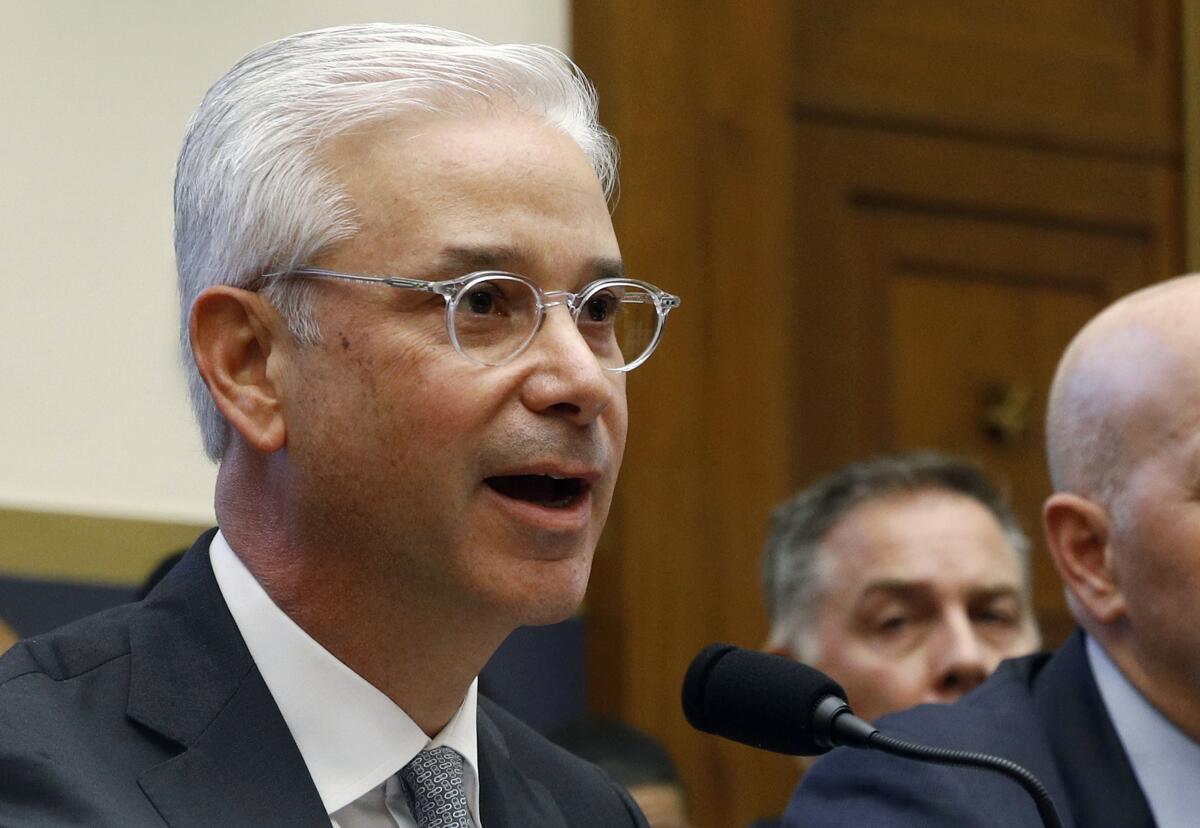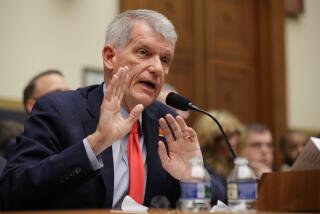Wells Fargo picks new CEO to lead turnaround: BNY Mellon’s Charles Scharf

Wells Fargo & Co. announced Charles Scharf as its next chief executive Friday, marking a new era in the bank’s efforts to turn itself around after a series of scandals claimed two previous CEOs in the last three years.
Scharf, the CEO of Bank of New York Mellon Corp., will replace interim chief Allen Parker on Oct. 21, capping a wide-ranging hunt for an outsider who could fix the San Francisco-based lender’s relations with the government and reinvigorate the bank, whose stock has fallen behind rivals’ in recent months. Shares of Wells Fargo climbed 3.8% on Friday. BNY Mellon shares slid 4.5%.
‚ÄúWith more than 24 years in leadership roles in the banking and payments industries, including as CEO of Visa Inc. and Bank of New York Mellon, Charlie has demonstrated a strong track record,‚ÄĚ Wells Fargo Chair Betsy Duke said in a statement.
The appointment ends a six-month search after former chief Tim Sloan stepped down in March, bowing to political and regulatory scrutiny. The process drew fire from some investors who said the board was taking too long and failing to update the market on its progress. Parker, Wells Fargo’s general counsel, has been running the bank in the interim.
‚ÄúGiven Scharf‚Äôs industry experience and familiarity with the challenges, we have more confidence the company will be able to move quickly and remediate lingering regulatory issues, improve expense leverage and reignite growth,‚ÄĚ David George, an analyst at Robert W. Baird & Co., said in a note.
Scharf, 54, will be charged with mending ties in Washington, where Wells Fargo‚Äôs problems are hardly over: The bank still faces several investigations and outstanding consent orders, including a growth restriction imposed by the Federal Reserve. Because of the intense regulatory scrutiny, Scharf‚Äôs appointment was subject to approval from the Office of the Comptroller of the Currency, which said in a statement Friday that it had ‚Äúno supervisory objection.‚ÄĚ
Other problems await Scharf in some of the company’s core businesses. The bank has posted years of muted revenue growth, now compounded by falling interest rates and declining loan balances. JPMorgan Chase & Co. has pulled ahead of Wells Fargo in consumer banking, generating about $2 billion more from the business. Two years ago, Wells Fargo was ahead by almost $1 billion.
Scharf has had several roles leading businesses that directly deal with consumers, said Kevin Barker, an analyst at Piper Jaffray & Co., noting that the new CEO will be the first outsider to lead Wells Fargo in several decades.
One incentive that helped persuade Scharf to make the jump: a 40% pay hike. His target compensation was set at $23 million, up from $16.5 million in his final full year at BNY Mellon.
Wells Fargo‚Äôs business model is still ‚Äúextraordinary,‚ÄĚ Scharf, a longtime protege of JPMorgan CEO Jamie Dimon, said on a conference call Friday. Resolving regulatory issues will be his top priority, he said, adding that he has not yet set a timeline for strategy or targets.
Duke said on the call that ‚Äúwe‚Äôre pretty well along‚ÄĚ on the bulk of the regulatory work needed.
Wells Fargo has brought in several JPMorgan veterans, including Chief Risk Officer Amanda Norton and technology head Saul Van Beurden, as it turned over its top ranks in the last three years. Throughout Wells Fargo‚Äôs CEO search, JPMorgan ‚ÄĒ the nation‚Äôs largest lender ‚ÄĒ was widely seen as having the most current and former executives capable of doing the job.
Scharf joined Visa as its CEO in November 2012 after a decade at JPMorgan, where he led retail banking before taking over an investment arm. He oversaw Visa during a time when the industry’s profits snowballed as consumers around the world increasingly turned to electronic payments. Then he moved to BNY Mellon, where he struggled to turn around the trust and custody bank; shares are still below where they were when he took over more than two years ago.
Scharf left Visa in 2016 to be closer to his family on the East Coast. He’ll run Wells Fargo from New York, according to the statement.
The bank‚Äôs new CEO ‚Äúmay be pivotal in moving Wells Fargo forward from recent issues and executing a long-term strategy to drive profitable growth,‚ÄĚ Alison Williams and Neil Sipes, analysts at Bloomberg Intelligence, said in a note. ‚ÄúIn addition to his CEO roles at BNY Mellon and Visa, Scharf‚Äôs experience in running JPMorgan‚Äôs retail business will serve him well in his new role.‚ÄĚ
String of scandals
Scandal erupted at Wells Fargo in 2016, with the revelation that employees had created millions of potentially fake accounts in order to meet sales goals. The ensuing fallout claimed then-CEO John Stumpf, and the board chose Sloan, a three-decade Wells Fargo veteran and Stumpf’s heir apparent, to take the top job.
Problems emerged in more business lines during Sloan’s time at the top, prompting additional scrutiny and calls for his ouster from lawmakers including Sen. Elizabeth Warren (D-Mass.). The rebukes from politicians and regulators got louder, culminating in a congressional hearing and a pair of public criticisms from the Office of the Comptroller of the Currency and the Federal Reserve in March. Sloan announced his retirement days later.
As part of the fix, Wells Fargo has been focusing on cutting expenses, which have been pushed higher by legal costs, remediation and fines. The company still employs more people than any other U.S. bank, and its revenue per employee has trailed behind most major competitors‚Äô in recent years. Sloan had said he planned to cut headcount ‚ÄĒ currently around 263,000 ‚ÄĒ by as much as 10% over three years, but Scharf may decide on a different route.
Parker will continue at Wells Fargo as the company’s general counsel, according to the statement.
More to Read
Inside the business of entertainment
The Wide Shot brings you news, analysis and insights on everything from streaming wars to production ‚ÄĒ and what it all means for the future.
You may occasionally receive promotional content from the Los Angeles Times.










